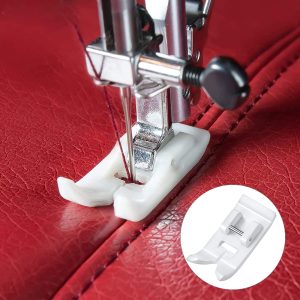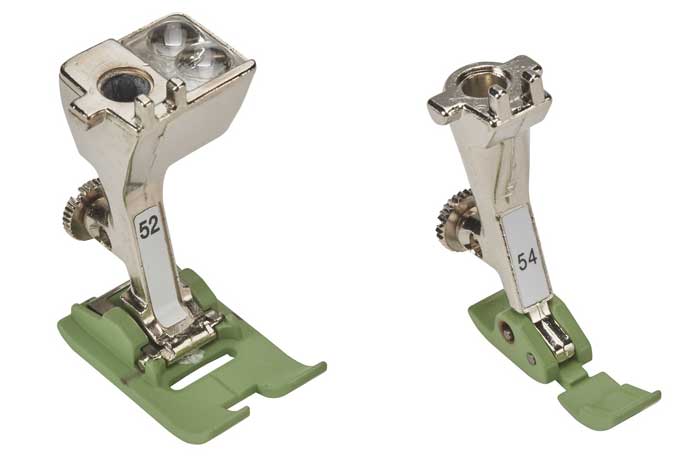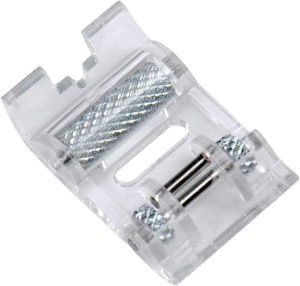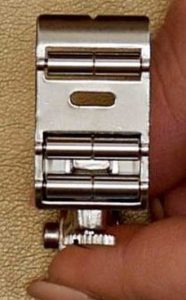
Nothing is more frustrating than uneven stitching—your thread stitches can go from long to short in an instant, ruining your line of topstitching or seaming. In severe cases, the wickedly short stitches can damage fragile fabrics by creating a hole, and some fabrics don’t take kindly to ripping out stitching and beginning anew.
Stitching in one place isn’t a normal option, but sometimes you can end up doing so accidentally. This phenomenon often occurs on fabrics that tend to stick to the presser foot, sometimes causing things to come to a complete standstill. Vinyls, plastics, foams, laminated fabrics, suedes and leathers are the most frequent culprits as they can actually adhere to the bottom of metal presser feet. Add in a bit of warmth from the sewing machine light and voila—a sudden slowdown.
The solution: Always test-stitch and switch presser feet if there’s an issue.
Many sewing machine companies make non-stick presser feet specifically to handle these pesky fabrics. Depending on the brand of machine you own, you may be able to buy multiple types of non-stick feet for your machine, including those for zigzagging, straight stitching, decorative stitching or zipper insertion. Some non-stick feet can also accommodate a built-in dual-feed mechanism. Check with your dealer or look for generic non-stick feet for the same purposes.
If a non-stick foot isn’t available for your machine model, or you prefer not to purchase one, but still need a little gliding power, try this: Purchase some frosted tape the width of your presser foot base and cover the bottom of a regular foot with the tape. Use the handwheel to perforate the needle hole in the tape and carefully trim the tape to clear the needle area for stitching. Peel off the tape when you’re done with your project.

A Close Cousin…a Roller Foot

A close cousin to the non-stick foot is a roller foot. This unique foot serves the same purpose as the non-stick foot and upon careful examination, you’ll see that it has one or more tiny rollers built into it. The roller mechanism keeps the foot just slightly above the machine feed dogs for easier feeding. Some roller feet are made from metal, others from non-stick material. Like its non-stick counterparts, the roller foot helps eliminate uneven stitching on sticky fabrics as it simply rolls over the surface without allowing any adhesion that can create uneven stitches.
Think of a roller foot like you think of snow tires for your car—a little bit of extra traction to keep things moving smoothly.

Note that some roller feet have smooth rollers, while others have cross-hatching for gripping the fabric surface. If you have a very delicate fabric, like chiffon or Lycra, it’s best to opt for smooth rollers to avoid imprinting or potential snagging.
Beyond Sticky
Both the roller foot and the non-stick foot can be used not only with those fabrics that tend to stick and cause uneven stitching, but they can be used with equal aplomb on bulky and “spongy” fabrics like bouclé, tweed suiting, bulky wool coatings and any type of fabric with an uneven surface or heavy nap. The rollers on the roller foot will glide over the surface irregularities without snagging or having the presser foot toes hang up on loose threads in a bulky weave.
If you’re stitching on paper for cardmaking, a roller foot can also be helpful for more even feeding, particularly on textured and novelty papers. Handmade papers, and those with seeds and natural materials incorporated are ideal to pair with either a roller foot or non-stick foot for effortless stitching.
~Linda Griepentrog is the owner of G Wiz Creative Services and she does writing, editing and designing for companies in the sewing, crafting and quilting industries. In addition, she escorts fabric shopping tours to Hong Kong. She lives at the Oregon Coast with her husband Keith, and three dogs, Yohnuh, Abby, and Lizzie. Contact her at gwizdesigns@aol.com.





